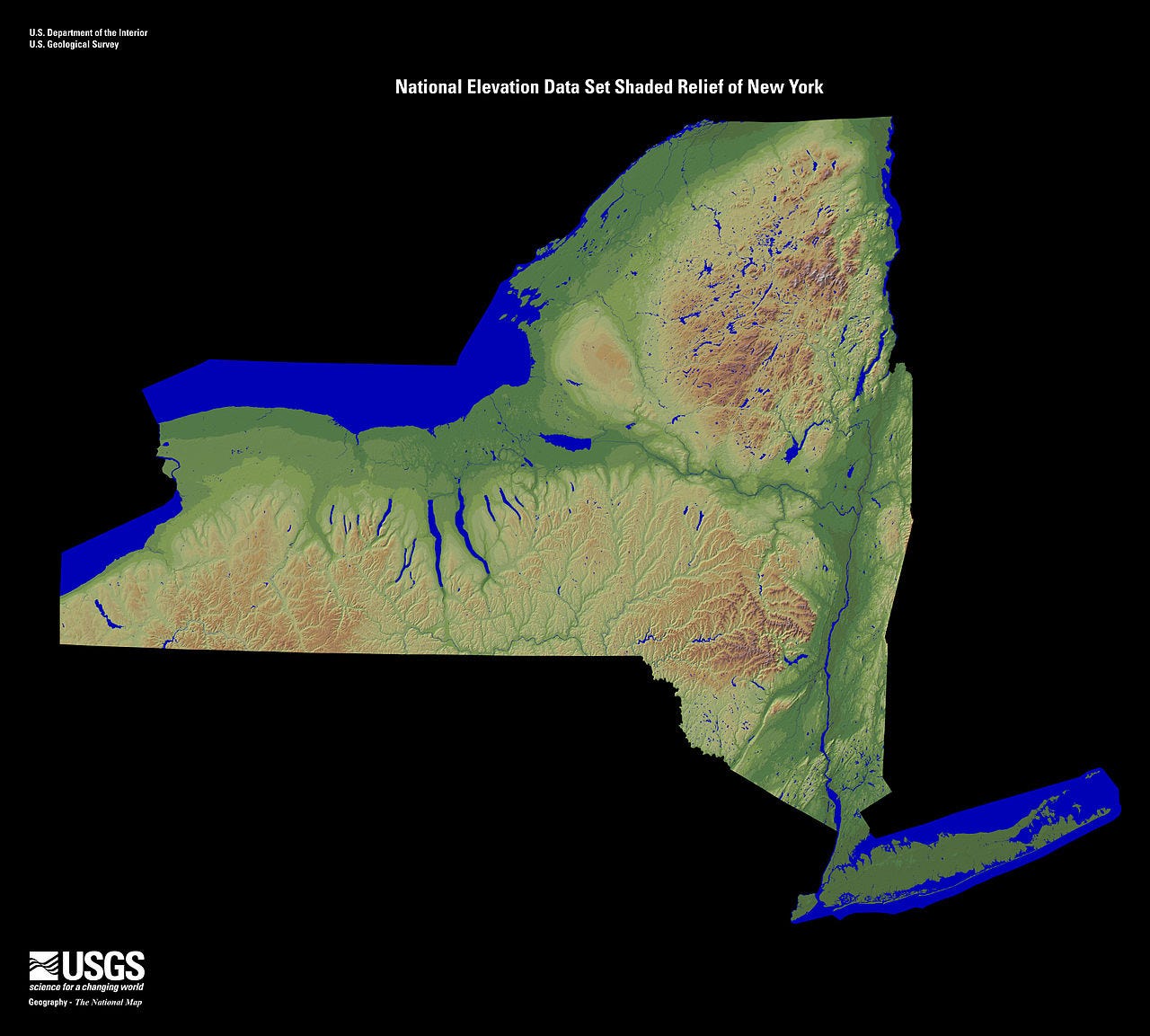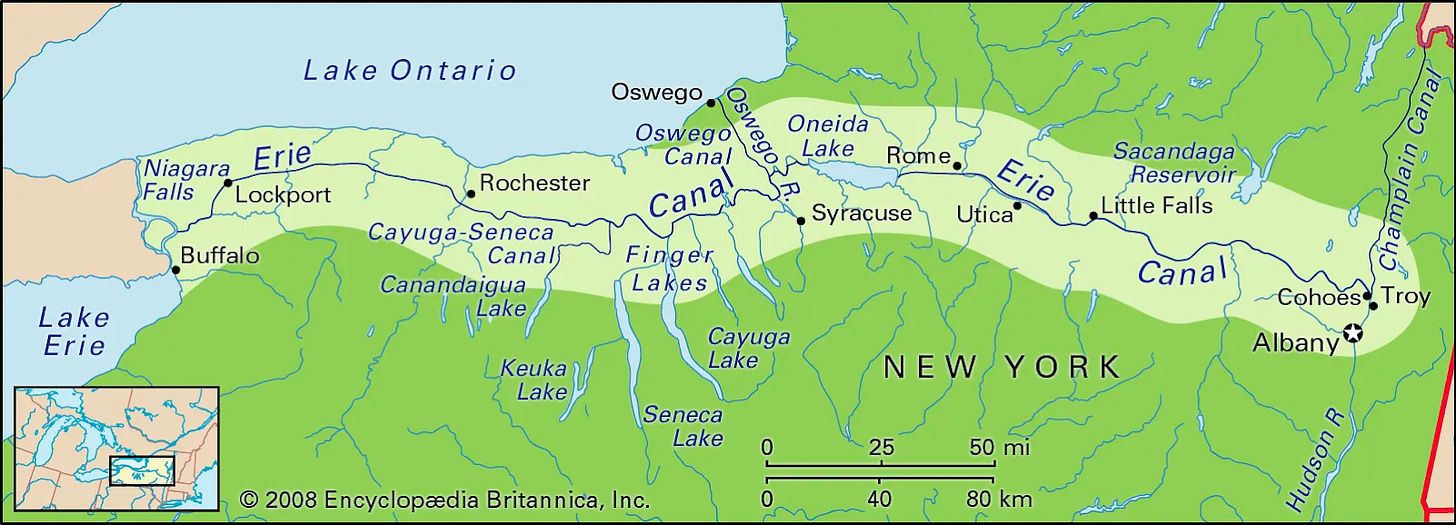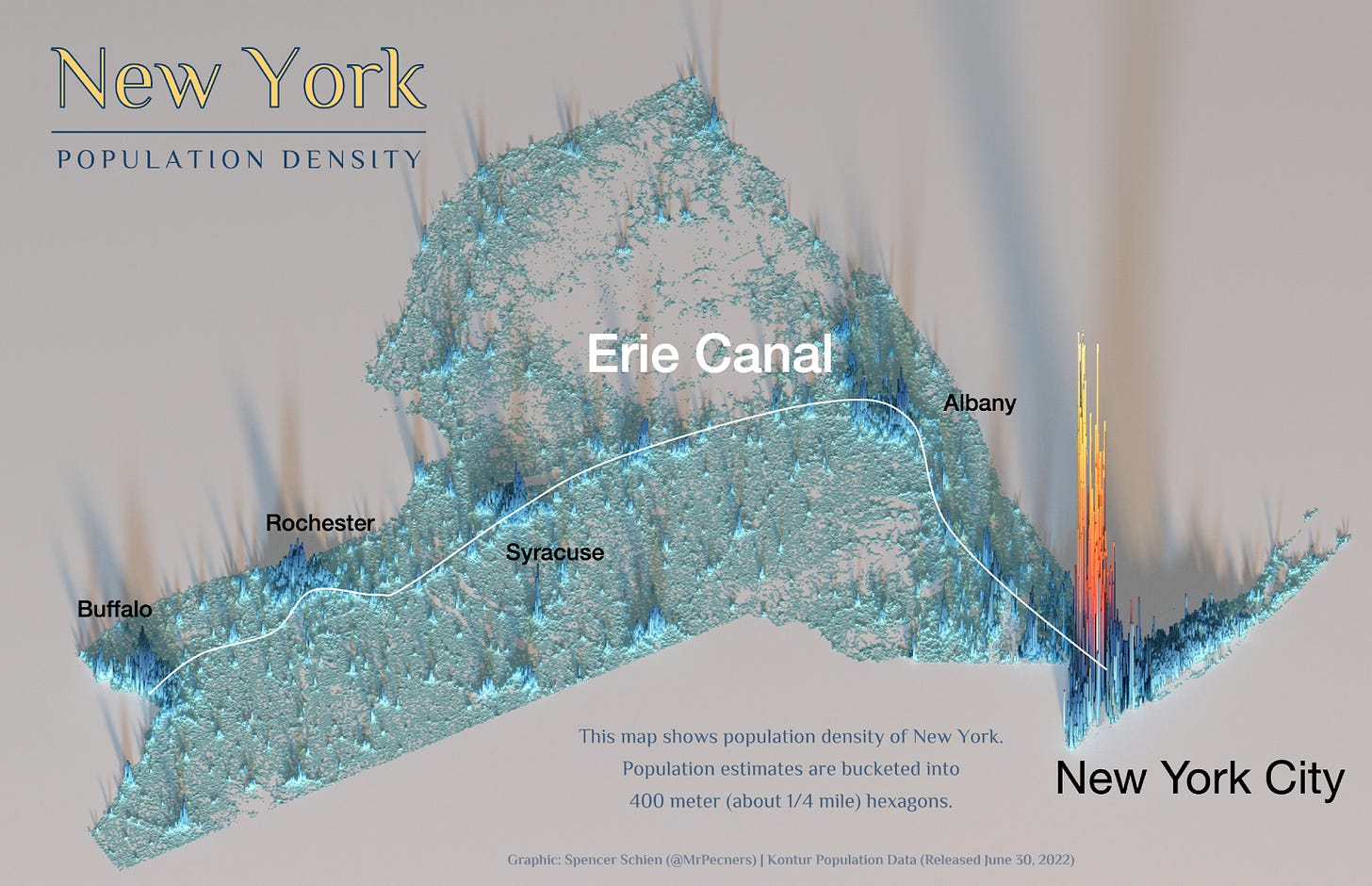Why Is New York So Big?
And why is it bigger than Québec or Montréal? Plus a quick look at New Orleans
The other day, we saw why Chicago is so big: It’s the connector between the Great Lakes region and the Mississippi region. Naturally, you’d expect other huge cities connecting other regions. For example, connecting the Great Lakes with the Atlantic, or the Mississippi region with the Atlantic
New Orleans is the big connector to the Atlantic.
It’s pretty impressive when you look at it on the map. It's a nearly continuous port for miles and miles.
So that’s for the Mississippi and the Atlantic. But the Atlantic Coast is huge. Why is New York the big connector between the Great Lakes and the Atlantic? Why not Boston, or Philadelphia, Baltimore, Charleston, Norfolk? Many of these are big cities, but none approach New York.
Here’s the physical barrier of the Appalachians:
In the early years of the United States, transportation of goods between the coastal ports and the interior was slow and difficult. Close to the coast, rivers provided easy inland transport up to the fall line, since floating vessels encounter much less friction than land vehicles. However, the Appalachian Mountains were a great obstacle to further transportation or settlement, stretching 1,500 miles (2,400 km) from Maine to Alabama, with just five places where mule trains or wagon roads could be routed. Passengers and freight bound for the western parts of the country had to travel overland, a journey made more difficult by the rough condition of the roads. In 1800, it typically took 2½ weeks to travel overland from New York to Cleveland, Ohio, (460 miles (740 km)) and 4 weeks to Detroit (612 miles (985 km)).
If you wanted to bypass that, how would you go about it? You’d find the easiest way to cut through. What is that?
Do you see the pass?

If you want to break through the Appalachians, the easiest way is using a natural path already carved by nature. That is what the Hudson and Mohawk rivers have done over millions of years.
Being at the mouth of the Hudson River, New York thrived even before it was connected to the Great Lakes. It traded the goods from the Hudson hinterland. Among other things, the colony was a breadbasket and lumberyard for the British sugar colonies in the Caribbean. New York's population grew from 18,067 to 168,007 between 1700 and 1771.
In the 1800s, the US in general and New York in particular worked hard to improve its transportation. The first successful steamboat line opened in 1807 between New York and Albany.
This also explains why Albany is another big city in the state: It’s at the confluence of the Mohawk and Hudson, which gives it enough water to be navigable all the way to New York. Albany is the head of navigation of the Hudson River. From there, roads took the relay, since they followed the passage carved by the Mohawk River. If you were a pioneer landing in New York headed for the Great Lakes, you went first to Albany and took the roads from there. It simply made sense to increase the capacity of these passes and decrease their operation costs.
Prior to the advent of railroads, water transport was the most cost-effective way to ship bulk goods. A mule can only carry about 250 pounds (110 kg), but can draw a barge weighing as much as 60,000 pounds (27,000 kg) along a towpath. A canal could cut transport costs by about 95 percent.
That’s why New York built the Erie Canal. Completed in 1825, it was the first navigable waterway connecting the Atlantic Ocean to the Great Lakes, vastly reducing the costs of transporting people and goods across the Appalachians. In effect, the canal accelerated the settlement of the Great Lakes region, the westward expansion of the United States, and the economic ascendancy of New York State.
New York was already big, but this made it huge.
Linking the Atlantic Ocean and the Great Lakes, the canal was an act of political will that joined the regions of the state, created a vast economic hinterland for New York City, and established a ready market for agricultural products from the state's interior.—The Encyclopedia of New York State, Eisenstadt, Peter.
We can see the path of the canal in current maps of population density
After that, New York’s investment in transportation continued to grow. In 1831, the Mohawk and Hudson Railroad started the country's first successful regularly–scheduled steam railroad service. Advancing transportation quickly led to settlement of the fertile Mohawk and Genesee valleys and the Niagara Frontier. Buffalo and Rochester became boomtowns. By 1840, New York was home to seven of the nation's thirty largest cities. At the start of the 20th century, the state was serviced by over a dozen major railroads. After railroads came highways, and after that airports. We know the story.
Side note: All of this also explains why New York City is not the capital of the state. New York’s role is that of a marketplace for the world. Today it connects the US with the world. Yesteryear, it connected the Great Lakes with the Atlantic. And before that, it connected the Hudson Valley to the Atlantic. This makes it an exceptional place in the state, which has very little coast and a lot of mountains. It was not representative of the state. Putting the capital there would always focus everything in the state around the city. Putting it in Albany, meanwhile, was a good compromise: It has halfway through the Hudson Valley, and on the confluence with the Mohawk River, which meant it was always going to be an important city in the middle of the state, in a representative inland area.
But more questions emerge.
Why was the Erie Canal built to Lake Erie and not the much closer Lake Ontario?
Why did we even have to cut through the Appalachians, when there was already a direct route to the ocean… following the St Lawrence River through Québec and Montréal?
As a result, why aren’t Québec and Montréal bigger than New York? The reason is a fascinating story of settlers and great powers vying for power against the geography. I’ll write about it in this week’s premium article.











This article is particularly interesting as I am currently living in Upstate NY exploring the Erie Canal and understanding how all the cities were built along its path (Syracuse, Rochester etc).
Today we are taught that the Robber Barons were an awful breed of people but without them and men like them even today, we would all be worse off for it.
Cornelius Vanderbilt built the New York Central Railroad, which became one of the largest and most profitable railroads in the United States. The New York Central Railroad helped to connect the East Coast with the Midwest, which helped to boost economic growth in both regions.